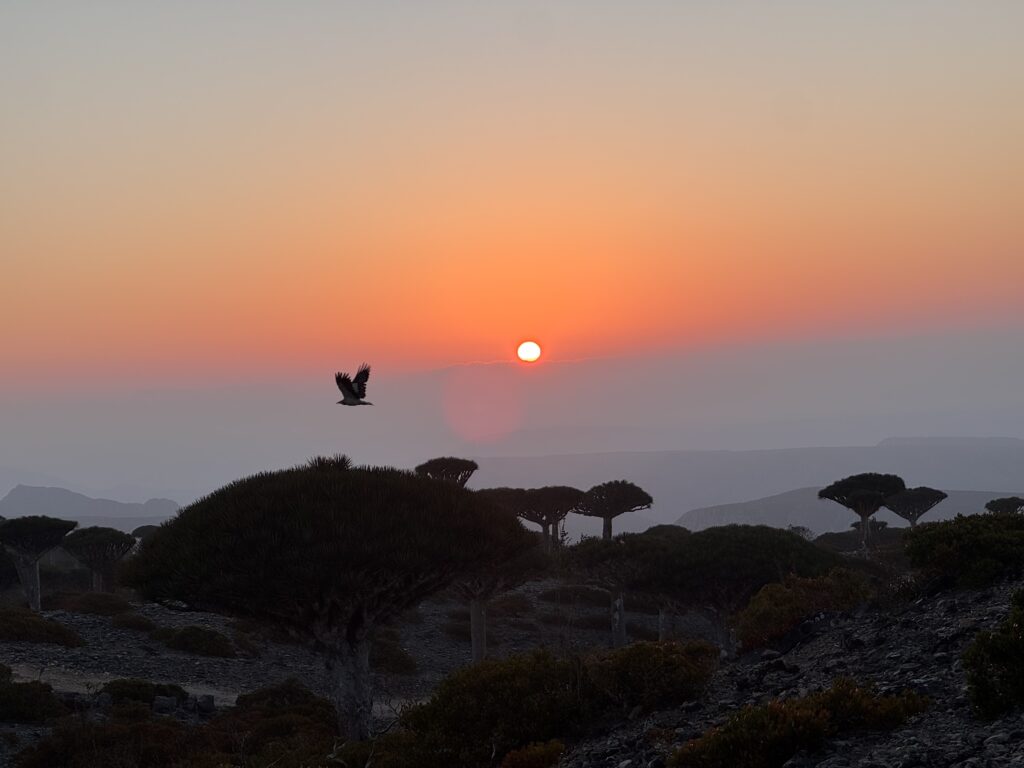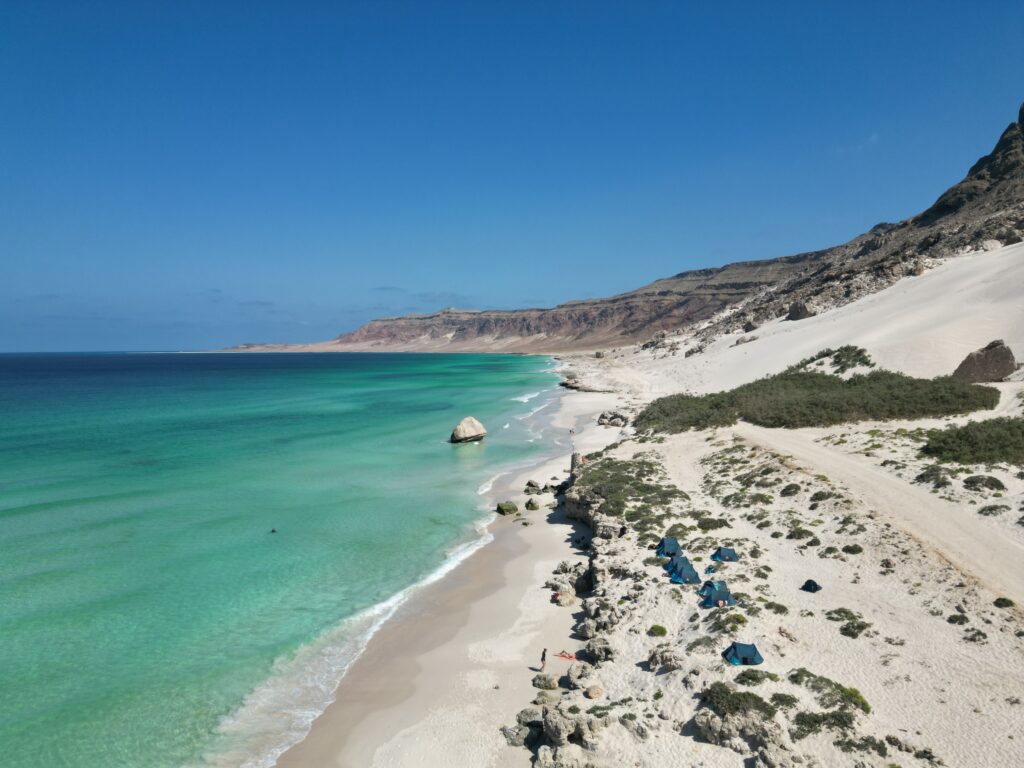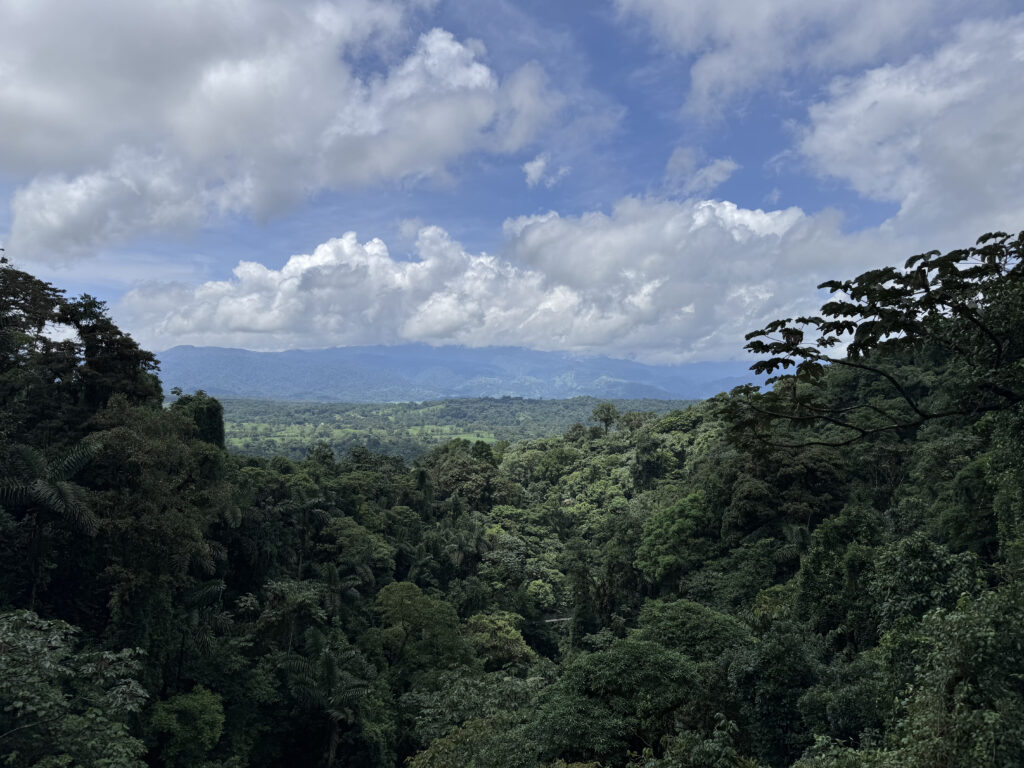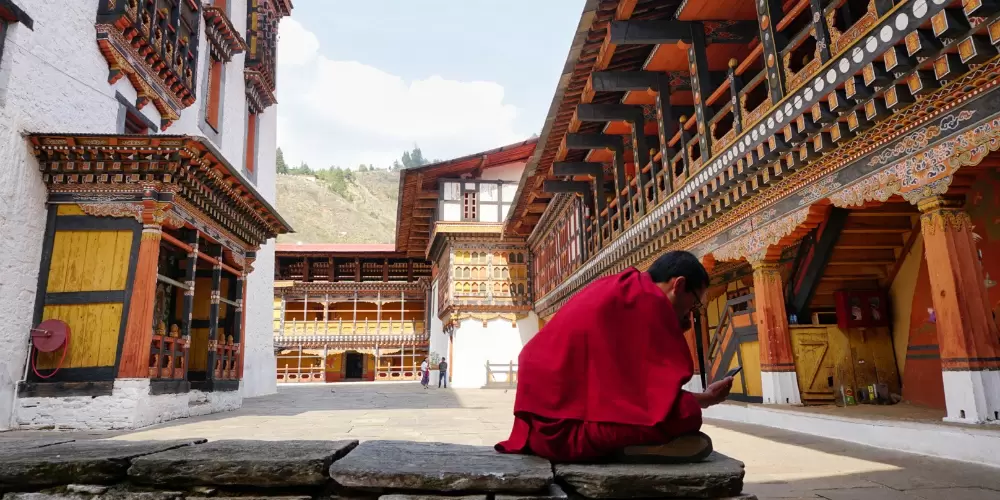Between Africa and the Arabian Peninsula lies an island that feels almost otherworldly.
Socotra, officially part of Yemen, is both geographically and ecologically a world of its own. With its twisted dragon blood trees, pristine white beaches, crystal-clear waters, and a biodiversity found nowhere else on Earth, it looks more like a film set than a real place. And yet it exists as a forgotten paradise that remained cut off from the outside world for decades.
What Socotra teaches us about sustainable tourism
Sustainable tourism is not a luxury on Socotra, but a necessity. How do you ensure that a hidden paradise remains hidden? Socotra, an island known for its otherworldly landscapes and rare biodiversity, faces that challenge. The island is so unique that UNESCO has recognised it as a World Heritage Site.
During my trip, I was struck not only by the island’s overwhelming natural beauty and the warm hospitality of the local people, but also by how Socotra is struggling to find a balance between growing tourism and preserving its unspoilt character. That balance is fragile and requires careful choices.
To better understand this complex challenge, I spoke with Rafa, owner of SocotraRafaTours, a local tour operator who deals with this balance on a daily basis. His insights offer valuable lessons for destination marketers worldwide.
The magic of Socotra
According to Rafa, Socotra’s uniqueness lies in its unspoilt nature. ‘We don’t have any large buildings; everything is still fresh,’ he explains. ‘The island is home to rare flora and fauna, such as the iconic dragon’s blood tree and the desert rose, species that are found nowhere else in the world.’
Socotra’s biodiversity is equally remarkable. ‘Beaches such as Arhar Beach and Shuwaab Beach, where dolphins appear, are breathtaking. But visitors are also amazed by the mysterious infinity pool and the lush forests with dragon’s blood trees,’ Rafa says enthusiastically.
What is particularly striking is that almost every visitor leaves with rave reviews. ‘There are never any negative comments,’ emphasises Rafa. ‘People often come back several times.’
These positive reactions perfectly match my own experience. What struck me most was the magical experience of the nights in the forest of dragon’s blood trees. When darkness fell, a breathtaking scene unfolded: the silhouettes of the dragon’s blood trees stood out sharply against a sky full of twinkling stars. The clear dark sky, free of light pollution, made me feel like I was on another planet. An almost surreal experience.
The next morning, I woke up early, just in time to see the sunrise. The sky turned pink, yellow and orange, an enchanting spectacle that set the sky ablaze. That moment, surrounded by the rugged silence of Socotra, felt like pure magic. A memory that will stay with me forever.

Growing tourism on Socotra: an opportunity and a challenge for sustainability
The tourism sector on Socotra has grown rapidly in a relatively short period of time. ‘Ten years ago, we only had 150 visitors a year,’ says Rafa. ‘Nowadays, we welcome around 3,000 to 3,500 tourists every year.’
That may seem modest, but for a small island like Socotra, it is a significant increase.
Rafa emphasises that Socotra’s geographical location contributes to this growth. ‘Because Socotra is far from the mainland of Yemen, visitors feel safe here.’ The recent flight connection from Abu Dhabi has also played an important role in the island’s rising popularity.

The role of the UAE: growth and balance
The United Arab Emirates (UAE) has played a crucial role in Socotra’s recent development, both in terms of infrastructure and tourism. Rafa explains:
‘The direct flight from Abu Dhabi to Socotra has changed everything. Without that flight, we wouldn’t have had these tourists and tourism wouldn’t have given such a boost to the local economy.’
The UAE’s influence goes beyond tourism. It has invested heavily in electricity, providing Hadibu, Socotra’s capital, with a reliable power supply. They also support fuel supplies, have improved the road infrastructure and provided assistance in the areas of healthcare and education.
‘For many residents, life has improved significantly thanks to these developments,’ says Rafa. ‘Given the war in Yemen, Socotra would have faced major challenges without this support.’
The UAE has undeniably contributed to Socotra’s growth and stability. But how can the island ensure that this support does not turn into dependence? This increasing involvement raises questions: how can Socotra maintain control over its future? And how can the island benefit from foreign investment without losing control over its unique identity?
It is crucial to maintain this balance. Socotra’s future depends not only on investment, but also on the choices made to protect the island’s identity and the rights of its local population.
The fine line between growth and sustainable tourism
Tourism on Socotra is growing, but this also poses a risk to the fragile nature and culture. Rafa emphasises that most visitors are eco-tourists and that a conscious choice has been made for small-scale sustainable tourism. ‘We limit the number of visitors per week,’ he says. ‘This prevents the island from being overrun.’
There are also strict guidelines for visitors. ‘Guides instruct tourists not to pick plants, take shells or stones, or behave irresponsibly in protected areas,’ says Rafa. This helps to preserve both nature and culture.
Nevertheless, during my visit, I noticed that there was no clear long-term vision. Given the unstable situation on the Yemeni mainland, this is understandable. Although Socotra still seems to have control over its tourism, the lack of structured policy could quickly upset this balance.

UNESCO's contribution to tourism in Socotra
Socotra’s remarkable biodiversity and unique culture have led to international recognition. The island was designated a UNESCO Man and Biosphere (MAB) Reserve in 2003, Yemen’s first Ramsar site in 2006 and added to the UNESCO World Heritage List in 2008.
Despite this protected status, Socotra faces serious challenges such as environmental degradation, geopolitical tensions and climate change. To protect the heritage and promote sustainable tourism, UNESCO trains and supports Socotra’s guides and entrepreneurs in responsible tourism. Thanks to these training programmes, local guides and entrepreneurs learn how to make visitors aware of Socotra’s fragile nature and culture. This not only strengthens tourism but also increases local awareness of nature conservation.

Local community as a driver of sustainable tourism
Tourism now has a major impact on the local economy. ‘Ninety percent of the inhabitants benefit from tourism,’ says Rafa proudly. ‘People work as guides, drivers or in hotels. Even in rural areas, residents sell their products to tourists, from goat meat to dragon’s blood tree resin.’
Local guides and entrepreneurs also play an active role in protecting nature and preserving local culture. During tours, the guides not only share their knowledge about Socotra’s unique biodiversity, but also explain the rules for respecting the fragile environment.
They also tell stories about traditional customs, such as the significance of the dragon’s blood tree and the role of Soqotri music in local ceremonies. These stories foster greater understanding and appreciation among tourists and encourage conscious and respectful behaviour.
By actively involving residents in decision-making about tourism, not only is support created, but also a deeper connection with nature conservation. This involvement ensures that residents feel ownership of the tourism sector and remain motivated to protect their environment.
This personal involvement ensures that tourists are not just spectators, but conscious participants who make a positive contribution to preserving Socotra’s unique identity.
Rafa emphasises that this local involvement is essential for responsible tourism: ‘The inhabitants must benefit from the growth, otherwise they will lose confidence in the sector.’
Challenges and concerns for the future
Despite the positive developments, Rafa also sees challenges. ‘We only have two flights a week from Abu Dhabi, and they are often fully booked,’ he explains. This not only limits the number of visitors, but also makes travelling to Socotra relatively expensive. ‘A few extra flights or competition between airlines would make the island more accessible and lower prices,’ says Rafa hopefully.
However, this raises questions for me. If ticket prices fall and travel to Socotra becomes easier, the number of tourists could increase significantly. Although the island currently benefits from a small-scale tourism model, it remains to be seen whether Socotra can cope with a larger influx of visitors. The ecosystem is fragile and the local infrastructure is limited. More visitors could disrupt this delicate balance.
The challenge, therefore, lies in finding a middle ground: ensuring sufficient accessibility to support the local economy without flooding the island with tourists. This requires a forward-looking strategy in which nature conservation and sustainable growth go hand in hand.

Lessons in sustainable tourism from Socotra
Socotra offers valuable lessons for other places striving for sustainable tourism:
1. Maintain small scale
The limited access to Socotra, with only two weekly flights, inadvertently creates a natural visitor limit. This prevents overtourism and helps protect the island’s nature and culture. This small-scale approach contributes to an exclusive and authentic travel experience, something Socotra must continue to guarantee, even as tourism expands.
2. Put nature first
Socotra demonstrates that nature conservation must be a core value. Strict visitor guidelines, such as a ban on picking plants or collecting stones, protect the fragile natural environment. These rules are actively communicated by local guides, ensuring that visitors are not only informed but also made aware of their role in protecting the island.
3. Encouraging local entrepreneurship
In Socotra, 90% of the local population benefits directly or indirectly from tourism. By placing tourism largely in the hands of local entrepreneurs, such as guides, drivers or hotel owners, income remains within the community and support and ownership are encouraged. This model, known as community-based tourism, enables residents to shape the growth and direction of tourism. It ensures that income from tourism benefits the local economy and prevents external parties from dominating the sector.
4. Protecting against outside influences
The growing number of foreign investments in Socotra underscores the importance of strict regulations and enforcement. The risk that external parties will influence the unique identity of a destination requires clear frameworks that prioritise the interests of the local population.
5. Introducing a visitor contribution for nature conservation
Linking tourism directly to environmental conservation can help preserve the island’s natural environment. On Socotra, tourism revenues could make a greater contribution to protecting the unique flora, fauna and ecosystems. A visitor contribution could finance education, environmental management and local projects.
6. Develop a long-term vision for sustainable tourism
Socotra shows how vulnerable a destination can be without structured future planning. Although the island is currently thriving with small-scale tourism, without a long-term vision there is a risk of uncontrolled growth. A strategy that combines nature conservation, cultural preservation and local interests can ensure that the balance between tourism and environmental protection is maintained.

A fragile paradise that requires smart choices
Socotra is a destination where beauty overwhelms you and tranquillity embraces you. Precisely because this island is so special and fragile, tourism here requires careful management.
Rafa put it aptly: ‘We want people to experience Socotra as pure, unspoilt and full of wonder. But that is only possible if visitors also understand how vulnerable this place is and take responsibility for protecting it.’
The challenge for Socotra lies in finding that delicate balance: how can the island be accessible without harming its nature and culture? This requires concrete measures such as strict visitor quotas, investment in local guides who educate visitors about their impact, and sustainable policies that protect Socotra’s identity.
The future of Socotra requires a joint effort by visitors, entrepreneurs and policymakers. Only by making wise choices now can this fragile paradise retain its unique character for the local population and for future generations of travellers.
Isabel Mosk is a tourism strategist and founder of Sherpa’s Stories. She has worked for more than 50 destinations worldwide and specialises in tourism trends, strategy, positioning and storytelling.




